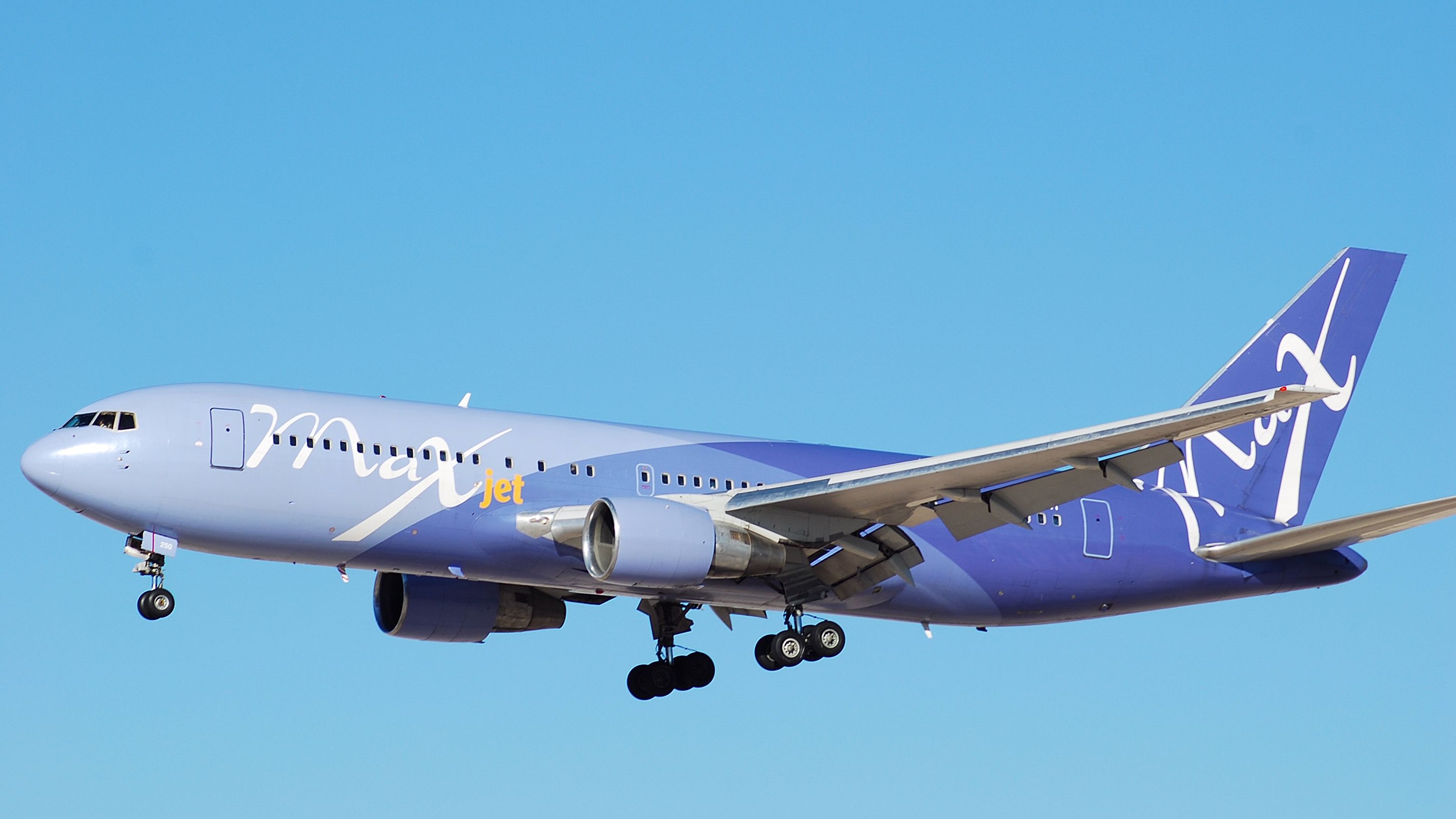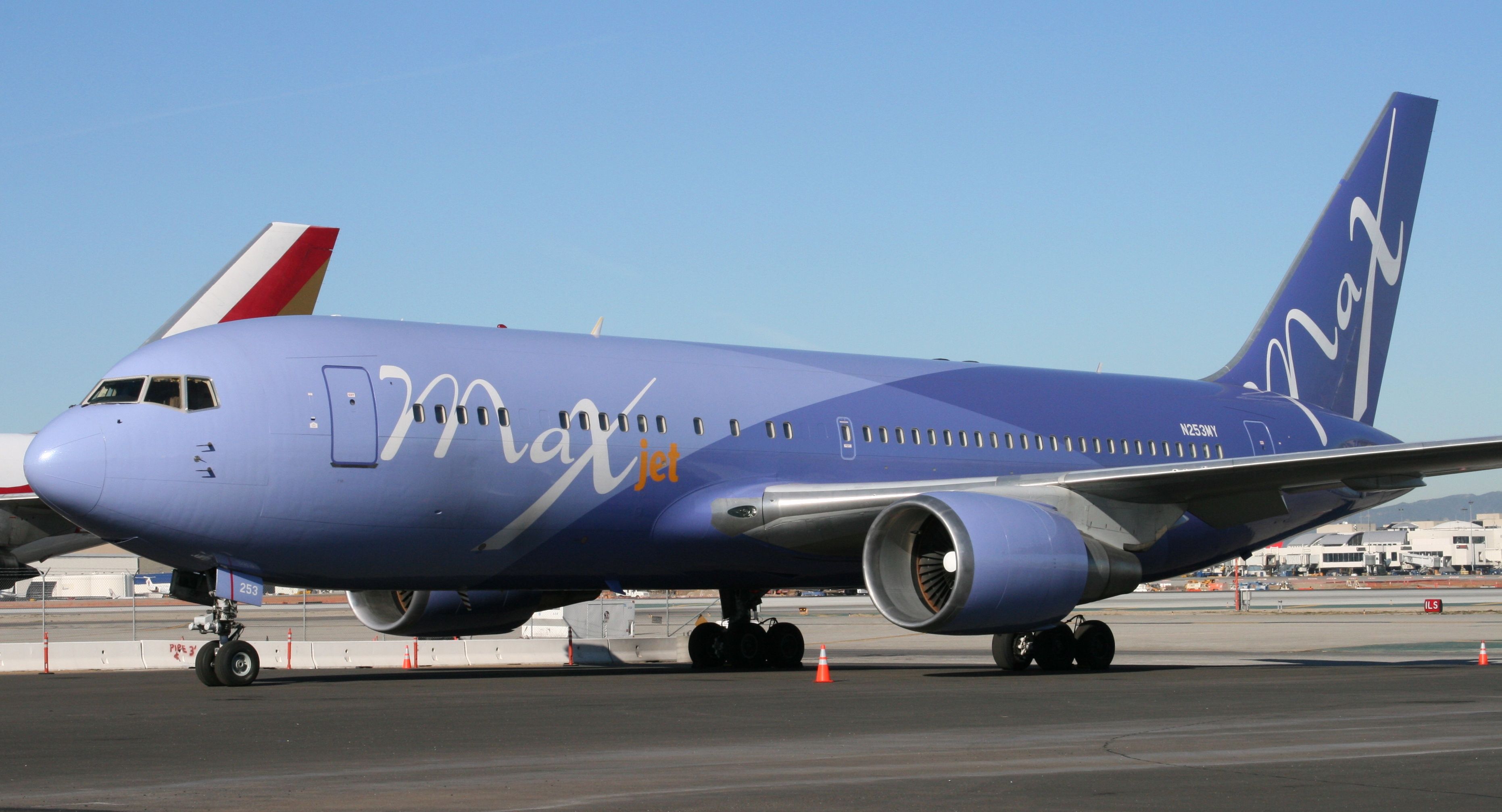All-business class airlines are something of a rarity nowadays but had become all the rage in the 2000s. Several such premium airlines popped up at the turn of the millennia, including MAXjet Airways, Silverjet, and Eos Airlines, but also ended up going bust by the end of the decade.
MAXjet Airways prided itself on being the first low-fare, business class-only airline with services from London Stansted Airport to New York. It was founded in 2003 but operated services for just over two years before ceasing operations in December 2007. Let's take a look at the short history of the United States-based all-business carrier.
A specific market
By the end of its run of conducting scheduled services, MAXjet had taken delivery of five planes, which were all Boeing 767-200s. During its peak, the airline had approximately 400 members of staff and operated flights between London Stansted (STN) and Las Vegas (LAS), Los Angeles (LAX) and New York JFK (JFK).
Altogether, MAXjet wanted to provide business and leisure travelers with a premium experience at a lower price than most of the carrier's competition. The 767s were fitted with up to 102 business class leather seats, each with 170° recline and plenty of room for movement. Fliers were treated to gourmet four-course meals, on-demand entertainment, and attentive service.
Quality across the board
Even on the ground, the company provided a high-quality experience that was tailored to both connecting and local traffic. For example, there were flexible check-in desks located in primary terminals, airside lounges, and contact gates. Customers went through Fast Track security and immigration to quicken the journey through the airport. Additionally, all travelers arriving with the airline were granted access to the MAXjet Arrivals Facility at the Radisson SAS Hotel by the terminal at Stansted.
According to the MAXjet archives,
"MAXjet targeted two primary groups of consumers: small business consumers and affluent leisure travelers. Small business consumers were price-sensitive and could not access high-volume discount programmes offered by other larger carriers. Affluent leisure travelers were willing to pay a modest premium over Economy Class for a more comfortable journey."
The carrier also offered cargo and charter flights, utilizing its belly space to offer between five and twenty metric tons per flight. As for its charter arm, the airline flew a variety of special clients, including sports teams, governmental organizations and high-net-worth individuals.
Hopping across the Atlantic in style
MAXjet's network consisted of business class transatlantic services between London Stansted Airport and Las Vegas, Los Angeles, and New York, although its headquarters was based at Washington Dulles. The company sought to connect travelers to key financial districts in the United Kingdom's capital, such as Canary Wharf and the City. It also sought to cater to corporate and affluent residential regions in Eastern England. Moreover, the famous Cambridge University is a forty-minute drive from Stansted.
London Heathrow and London Gatwick Stansted had gates and slots available during key travel times for flights across the pond. However, Stansted’s long, 3,048-meter runway allowed for long-haul operations to the US West Coast with full payloads. It also provided conditions for the transportation of large cargo payloads to the East Coast.
The regular published fares of the airline were often considerably lower than similar offerings by other operators. Including taxes and fees, its fares varied between $1,150 and $4,000 for a return ticket. Around 85% of cumulative passenger ticket sales were generated through direct sales channels, while 15% were purchased through travel agencies. Online outfits such as Expedia and Orbitz had a strong part to play in the sales process.
A twist of fate
Despite the grand ideas, the operator didn't reach its fifth birthday - and had been in operation less than two years - before facing serious financial difficulties. The firm was floated on the London Stock Exchange in July 2007. However, at the end of the same year, it announced that it was filing for Chapter 11 bankruptcy in the US. According to the Financial Times, MAXjet reported a net loss of $49.5 million in the first six months of 2007, following a net loss of $79 million in 2006, which was its first full year of flying.
MAXjet CEO Bill Stockbridge shared that its moves to raise additional capital had been unsuccessful. Thus, the board decided that a bankruptcy filing would be the best approach to protect the business’ customers and creditors.
The airline highlighted some of the key facts behind its financial decline - fuel price inflation, other operating cost increases, competitive pressures, and a drop in consumer spending all had a part to play. The company also noted that a considerable deterioration in financial market confidence had precluded any further fundraising.
These aspects were joined by an increase in competition. For instance, other airlines had increased capacity and were rivaling fiercely on price in key segments such as New York. SilverJet also notably aggressively reduced fares to gain a share of the market.
A tough climate
Ultimately, the carrier ceased scheduled flight operations on Christmas Eve, 2007. With some passengers awaiting a return flight from London Stansted, MAXjet recruited the help of all-business carrier Eos (itself to go bust less than a year later) to fly its stranded passengers home over Christmas.
MAXjet then restructured to conduct charter-only flights and retained operational authority until October 2009. Nonetheless, even if the carrier hadn’t ceased scheduled operations in 2007, it would have been likely to meet a similar fate in 2008 due to the global financial crises.
The airline's five Boeing 767s would find new homes after MAXjet went bust. Two of its planes joined Air Italy, another joined Air Seychelles, one joined Swift Air (and later Eastern Airlines), while the other was damaged beyond repair during a fuel leak in Fort Lauderdale in 2015 - none of the five jets are now in service.
Nowadays, if you want to fly on an all-business carrier then your options are severely limited. While some full-service airlines - including Singapore Airlines and British Airways - have operated all-business flights in the past, the only dedicated all-business airline in operation today is La Compagnie. The French carrier currently flies Airbus A321neo flights from Milan Malpensa and Paris Orly to Newark Liberty Airport.
What are your thoughts about MAXjet Airways’ operations during its short history? Did you ever fly with the airline when it was in action? Let us know what you think of the carrier in the comment section.
Source: Financial Times


